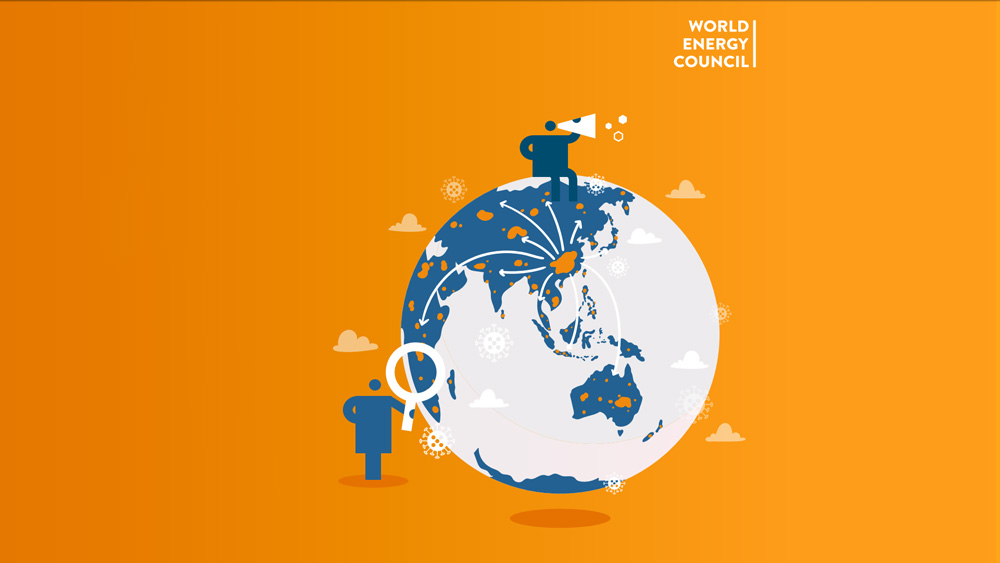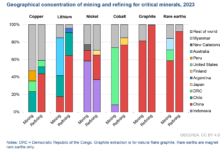World Energy Council Scenarios: Navigating the Ongoing COVID-19 Crisis
In response to the COVID-19 crisis, the World Energy Council (WEC) has developed 4 scenarios to support the global energy community in addressing the new and urgent leadership question of how we can emerge from the COVID-19 crisis as a more resilient society and continue to accelerate a successful global energy transition.
Shortly after the COVID-19 crisis began to impact the global energy industry, the World Energy Council launched a community-wide initiative to facilitate the exchange of best practices and provide tools for energy leaders to manage through the crisis and shape the post-crisis agenda. World Energy Council is conducting a series of pulse surveys of their global network of deep energy expertise from nearly 100 countries around the world. The ongoing surveys not only identify how the crisis has and continues to impact energy stakeholders around the world, but has enabled the development of plausible and alternative scenarios of what might happen. Organisations, governments, innovators and experts have already begun to use these scenarios to stress test exist strategies and to explore and navigate how we can emerge from the COVID-19 shock.
The Council aims to provide plausible and impartial scenarios as a reference set for the global energy community. They are using this set of scenarios to build a new leadership dialogue platform on which World Energy Council will convene energy transition ecosystem players. Used as a set, these scenarios can prompt better quality strategic conversation on the reallocation of investments, exit strategies and policy pathfinding needed to enable orderly global energy transition as the world emerges from crisis.
Many of the after-effects of COVID-19 will be with us for some time, and it may take a while to return to normal or a new normal. The Council’s scenarios are designed to see what is emerging even within the current fog of uncertainty.
Plausible alternative scenarios
How will this pandemic change the future? While no one can answer this question, World Energy Council identifies the relevant signals of change and creates plausible scenarios for what lies ahead.
Countries have focused their immediate concerns on addressing the challenge posed by the large number of those infected who need hospitalisation. Other responses have included utilizing ‘social distancing’, increasing hospital capacity and investing in the development of diagnostics, therapeutics and a vaccine. Even with this intensity of focused attention across the world, much remains unknown about the epidemiology of COVID-19.
The ‘unknowns’ of the COVID crisis cover every aspect of global response and recovery.
How pernicious is the pandemic? How well will countries cope? Will the pandemic be solved quickly with a medical technology fix, or will it require sustained behavioural changes?
The costs of tackling the pandemic worldwide have been already massive – an estimated USD 10 trillion to date as countries have been in lockdown, and economic activity has been in a historically deep recession. How quickly will the global economy recover? Will recovery happen in a way that builds trust within and between countries, through wider collaboration, or will governments and the public emphasise more self-reliance?
Once the pandemic is fully under control globally – and this might take 2-4 years – countries will be able to examine the legacy of COVID-19. Will countries return to a pre-pandemic agenda? Or will they engage with a more ambitious transformational agenda? And what are the implications for energy?
There are many shapers of the future, but three are particularly critical for governments and enterprises:
- The degree of ambition in addressing a wider resilience agenda, including climate change, or a reversion to the old agenda.
- Whether countries trust each other in addressing the pandemic and other global challenges, or whether recovery efforts reinforce self-reliance.
- Whether a global vaccine is found to solve the pandemic or sustained behavioural changes are needed.
WEC examines 4 challenging scenarios that explore the trust-ambition-control framework.
The 4 scenarios are: PAUSE – collaboration aiming at a return to normalcy; FAST-FORWARD – collaborative opportunities for transformation; REWIND – a turn away from globalisation to repair the local economy; RE-RECORD: bottom-up diverse experiments to create a human-centred transition.
PAUSE
After the imposed pause of the global pandemic lockdowns, societies open up and collaborate in an attempt to return to a pre-pandemic normal.
The advent of a vaccine and a desire to collaborate enables containment of the virus by 2022.
Energy demand slowly rises, although not to 2019 levels, and oil prices begin to recover, in part because the crisis has left fewer energy companies in the game. The slow recovery advantages big global corporations and the rich, leaving the poor and the poorly financed even further behind.
The slow rise in oil prices promises to make renewables competitive again, but only after a long recovery. With economies heavily scarred, the international community focuses more on stability, not transformation, and many countries attempt to set up the old international supply chains. Debt and uncertainty make it tough to finance new projects, significantly slowing the transition to a new energy economy. Most governments respond to the looming climate crisis with policies that emphasize stability rather than change. Although no one is willing to give up the Paris ambitions, there is a general acceptance that progress will be slower than expected.
FAST-FORWARD
While the pandemic has put economic growth patterns in reverse, it has put transformation and collaborative innovation on fast-forward. Successfully tackling COVID-19 through effective scientific collaboration, using big data, combined lab resources and rapid scale-up of vaccine manufacture invigorates the economy. A new world order is beginning to develop, with China on the rise. Effective partnerships create technology-enabled redundancy and resilience rather than efficient supply chains designed for lowest cost.
Collaboration among oil producers to control supply allows oil prices to rise. Against these prices, renewable energy becomes more competitive, especially when renewable infrastructures can be built on a collaborative basis. Collaboration also forms the basis of progress on climate change policy implementation – even though this progress towards a just transition, while faster than was expected, is still too slow to reach the reasonable 2030 emissions targets necessary for putting countries on-track to meeting 2050 commitments.
At the moment, quantification of COVID-19 scenarios can only be illustrative. However, World Energy Council assumes for each of the two ‘high trust’ scenarios that global GDP declines by 5% in 2020 with a bounce-back in 2021, and then an annual rise at historical rates to 2024. Such a recovery would boost demand for electricity, low-carbon sources would outpace coal-fired generation, and world oil demand would reach 2019 levels by 2022.
In Pause there is a strong focus on resolving economic challenges. In Fast-forward a rise of public support for addressing resilience challenges gives governments confidence in recovery policies that deliver on both economic and climate goals.
REWIND
Globalisation is rejected in a ‘me-first’ drive to repair the local economy. Vaccine development is slow, and governments look to behavioural fixes to tackle the virus. By the end of 2022 the US, UK and China all develop promising vaccines, giving priority to their own populations. Not all countries without vaccines handle the virus well, nor do they effectively manage the dramatic loss of economic activity. The global pandemic has exposed the vulnerability of global supply chains and the dangers of interdependence.
Most countries respond by pulling back, in a kind of rewinding of a taken-for-granted global order.
Some sectors, notably energy, agriculture, and pharma, face a growing protectionist movement as trade becomes less global and more bilateral.
An inward-turning, domestic focus creates a widening gap between rich and poor countries, with uneven recovery at every level.
This global decoupling extends to the energy transition as well. As demand rebounds in rich countries, a delay in the increase of capacity leads to a sharp rise in oil prices. Rich countries weather this, and some even continue developing their renewable energy capacities. But poor countries are left to their own resources, with a number relying more heavily on domestic resources such as coal.
RE-RECORD
The period to 2023 is gruelling. Bottom-up diverse experiments create a human-centred transition. Vaccines and treatments proliferate in a confusing, non-coordinated fashion, with very different outcomes on a city-by-city level. The slow economic recovery following the pandemic is accompanied by social unrest. Globalisation is on the backfoot. In most countries, workers at the low end of the scale, who have been acknowledged as ‘essential’, begin to demand greater equality and a more just society, starting with recovery programs that focus on job opportunities.
Under the three-pronged nudging of low-wage workers, local environmental activists, and the increasingly influential corporate social responsibility movement, governments offer national incentives for transformations in the energy infrastructure. Financial investment begins to migrate from fossil fuels to mixtures of fossil fuels and renewables on diverse pathways to circular economies and hybrid energy system. These local experiments, enabled by technology, begin to re-record the old version of the global energy infrastructure, with the creation of new, locally focused renewables, storage and regenerative options.
For each of the two ‘low trust’ scenarios World Energy Council assumes global GDP declines by 8% in 2020 with an annual rise at historical rates to 2024. With such a recovery wind and solar power would increase their share of generation to nearly 9% in 2020.
In Rewind energy security remains the cornerstone of policy. There are diverse approaches to climate change from disinterest to wide support, but overall progress remains inadequate.
Re-record involves very different degrees of success (and failure) in addressing the pandemic and a breakdown of global cooperation. In many countries the power to act is increasingly sub-regional and local community focused. There is social unrest in some areas, but also the pervasive rise of constructive local solutions.
The use of scenarios
Scenarios provide an inclusive and strategic framework that enables big-picture thinking and supports decision-making under uncertainty.
Scenarios are designed to be used as a set to explore and navigate what might happen, not what should happen. They help to stress test and design strategic and policy options and facilitate a better-quality strategic dialogue on the future of energy systems.
The Council promotes and uses plausibility-based COVID-19 crisis scenarios to prompt leadership conversation on reallocation of investments, exit strategies and a possible new integrated policy path to enable orderly global energy transition as the world emerges from crisis.
World Energy Council recognises this moment as unique in recent history – an opportunity to direct investments to global energy transition and to design strategies and policy paths to securing clean, affordable, reliable and equitable energy for all.
Methodology
The Council is following an agile scenario-building process that gathers informed insights across the globally diverse energy community and engages leadership perspectives on emerging developments.
Key steps of the process
- Assessing impacts of the crisis on organisations and countries through global community pulse surveys and regional experts’ conversations.
- Identifying critical uncertainties, developing a flexible scenarios framework and exploring emerging leadership themes.
- Using the scenarios framework to build an ‘open source’ strategic early warning system to identify and track signals of change and clarify implications for the pace and direction of global energy transition.
- Using the scenarios to prompt leadership conversation on investments, strategies and policies to enable orderly global energy transition.







